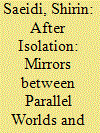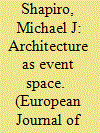| Srl | Item |
| 1 |
ID:
167419


|
|
|
|
|
| Summary/Abstract |
In this article, we theoretically conceptualise the renegotiation of participatory action and activism through the formation of intellectual space that is self-reflective and upheld by what we metaphorically describe as mirrors between parallel worlds. Rethinking what activism is and how an individual relates to their social group is dependent on different levels of self-reflection, self-criticism and competing scales of insertion of other people’s struggles into one’s own political vision in an effort to intellectually rectify the local tensions that emerge in a post-revolutionary context where people are disconnected from global-level activism. A significant aspect of this analysis is our interlocutors’ imaginative capacity to draw from other people’s experiences through cultural and visual artefacts and integrate them into their own life history with the intention to address national or group-specific dilemmas. While some have drawn attention to the importance of noting how spaces for activism are remade in the post-revolutionary context due to such sentiments as disappointment, we instead examine the formation of conceptual spaces of activism within the context of isolation in contemporary Iran. Empirically, we bring together a political analysis of the novel Bevatan by Reza AmirKhani, and interviews conducted with English literature students in Shiraz.
|
|
|
|
|
|
|
|
|
|
|
|
|
|
|
|
| 2 |
ID:
188404


|
|
|
|
|
| Summary/Abstract |
This article subjects the personal narratives about the domestic spaces of expatriate Britons in India, or Anglo-Indians, to close scrutiny. The households of expatriate Britons were intended to mirror the racial distance of the formal imperial spaces, like clubs, parks and gymkhanas. But far from being an extension of public spaces that separated the colonised and the coloniser, the households embodied the multiplicity of social spaces. Interpersonal relations in these households complicated this bifurcation substantially. Space played a crucial role in the construction of a hierarchy–intimacy paradox in the households, where interracial intimacies existed in tandem with imperial hierarchies.
|
|
|
|
|
|
|
|
|
|
|
|
|
|
|
|
| 3 |
ID:
169165


|
|
|
|
|
| Summary/Abstract |
Central to the conception of this article is the architectural theorist Bernard Tschumi's dictum, ‘There is no architecture without action, no architecture without events, no architecture without program … no architecture without violence.’ Shaped as well by Eyal Weizman's conception of ‘forensic architecture’, the focus of the investigation is on Israel's architecture of security and on the corresponding Palestinian architecture of resistance. Emphasising an encounter of cartographies that reveals the way Palestinians make life livable in response to the architectural violence they face, the analysis continues with reference to Yari Sharif's analysis of architectures of resistance and with a reading of a feature film, Hany Abu-Assad's Omar (2013) in which the Separation Wall between Israel and Palestine is one of the film's primary agent/protagonists. The article surveys popular culture texts, focused on crime and espionage to analyse a range of security practices and breaches that amplify the analysis with attention to security issues in individual households, multiple-person dwelling arrangements, architectural locations throughout cities, and buildings housing governmental security agencies. That trajectory of architectural sites lends a micropolitical analysis to the macropolitical level of governmental policy and modes of resistance to it.
|
|
|
|
|
|
|
|
|
|
|
|
|
|
|
|
| 4 |
ID:
146224


|
|
|
|
|
| Publication |
Cambridge, Polity Press, 2014.
|
| Description |
xi, 207p.: mappbk
|
| Series |
China Today Series
|
| Standard Number |
9780745669717
|
|
|
|
|
|
|
|
|
|
|
|
Copies: C:1/I:0,R:0,Q:0
Circulation
| Accession# | Call# | Current Location | Status | Policy | Location |
| 058744 | 339.470951/LIA 058744 | Main | On Shelf | General | |
|
|
|
|